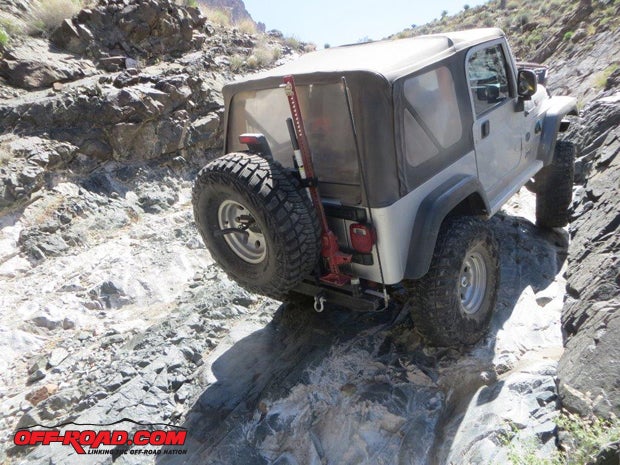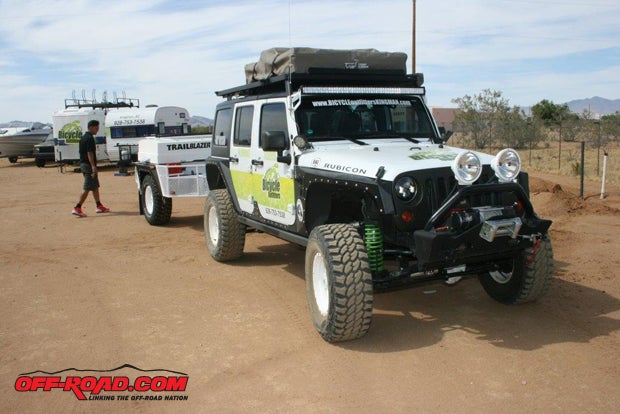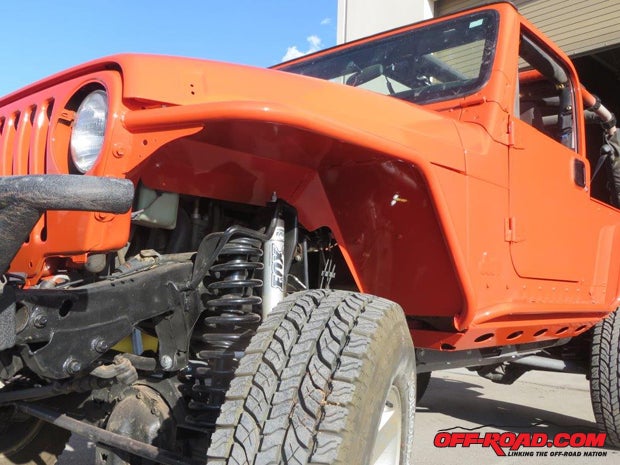
In your Jeep Creep questions, please list your first and last names, your hometown, and your state/province/country, so that we can publish that information here. If you don’t provide this information, we may not be able to publish your question and answer. Don’t forget to be as complete as possible with the description of your Jeep and its problems, too. Send your Jeep questions to editor@off-road.com, Attn: Jeep Creep.
Previous Jeep Creep Columns
June 2015
May 2015
Two Jeep recalls from NHTSA this month
(www-odi.nhtsa.dot.gov/recalls/monthlyreports.cfm)
15V-393: Chrysler is recalling certain model year 2014-2015 Jeep Cherokee vehicles manufactured January 4, 2013, to February 18, 2015, and equipped with a power liftgate option. In the affected vehicles, water may enter the power liftgate control module and cause a high-resistance short circuit in the module. A short circuit in the liftgate control module may result in a fire. Chrysler will notify owners, and dealers will inspect the power liftgate control module and connectors for corrosion, substitute a bolt for the threaded grommet installed to seal an attachment point used in non-power liftgate vehicles and cover the power liftgate control module in a foam water shield, free of charge. The manufacturer has not provided a recall schedule yet. Owners may contact Chrysler customer service at (800) 853-1403. Chrysler’s number for this recall is R27.
15V-407: Chrysler is recalling certain model year 2015 Jeep Grand Cherokee and Dodge Durango vehicles manufactured June 12, 2015, to June 20, 2015. Due to a manufacturing error, the affected vehicles have rear lower control arms that may fracture. If the rear lower control arm fractures, the vehicle may have a sudden change in ride height, rear end instability and/or reduced braking, increasing the risk of a crash. Chrysler will notify owners, and dealers will inspect the vehicles and replace any affected rear lower control arms, free of charge. The recall began on July 10, 2015. Owners may contact Chrysler customer service at (800) 853-1403. Note: Owners are advised not to drive their vehicle until it has been inspected at the owner’s location. Vehicles will be towed to dealers for repairs as necessary.

Seeping and Weeping
I have a 2013 Sahara Unlimited with 33K miles on the clock. Within the last 5K miles I’ve smelled coolant on two circumstances in both winter and summer driving conditions in Colorado. 1) After the rig has been driven and is fully warm, I turn off the engine and walk around to the front of the vehicle the smell seems to be coming from the driver’s side of the grille/engine compartment. 2) At idle with the driver’s side door open, the smell of coolant rises from under the vehicle. I’ve taken this JK to two dealers, each has pressure tested the system and found no loss of pressure in the system. The first dealer commented on the coolant tank being low and filled it, the second commented on the tank being overfilled. On the drive to the first dealer the dash temp gauge showed the temp slightly above normal and it tends to get slightly above normal when I’m on a trail moving slowly. Since the coolant tank was topped off the temp gauge hasn’t shown higher than normal readings on the highway or street which is where most of my driving is done. I presume the highly skilled and trained technicians at the two Jeep dealers had the cap on their check list yet who knows. However the cap is on the passenger side of the radiator with no smells emanating and no signs of leaks that are visible. I’ve been keeping an eye on it and not noticed any change; the second dealer removed some of the coolant to the proper level.
Larin Felker
Denver, Colorado
I think you experienced a seeping cap. If it had a slightly crimped gasket, the wrinkled gasket could have been causing a very weak leak. Denver’s altitude with its reduced air pressure would have been increased the possibility of this happening. Taking the radiator cap off and putting it back on could have straightened out the gasket and it’s no longer seeping. And the reservoir level has not gone down since the test. If it begins seeping again, give me a shout.
Old School V8
I have a ‘73 CJ-5 with a 304 with headers and dual exhaust, 31-inch tires, 3.73:1 gears (although I may eventually change to 4.10), a mid-range camshaft, and 401 valves in the 304 heads. I am getting ready to install an Edlebrock Performer dual plane intake and late ‘60s/early ‘70s non-electric Rochester Quadrajet carburetor. Yes, its old school! I know that Quadrajets are extremely tunable, and need some assistance in the initial set-up. I don’t know what car/engine the Q-jet was originally installed on. Can you give me any pointers on selecting appropriate primary jets, primary and secondary metering rods and secondary metering rod hanger for my CJ? If I start close, I can fine tune it from there.
Colin Whittaker
Richmond, VA
I fondly remember my ‘74 CJ5, which I upgraded to a built, blue-printed, and balanced 401 with a Super T10 4-speed. I’d recommend you bypass the 4.10 gears and go directly to 4.27:1 gears, which is what mine had from the factory. They’re a great ratio, especially if you eventually go to 33” or 35” tires. I’d also recommend you forget the Quadrajet and move directly to an EFI system (Holley, Howell, etc.). You’d be much happier in the long run. However, if your mind is set on the Quadrajet, take a peek at http://www.quadrajetcarbs.com/?gclid=CProjJvqt8YCFQGJaQod1bgD1w.
Get the Hook
I have a 1979 CJ with a 5.7L Corvette V8 engine with ignition problems. The engine starts and runs until I move the key back from the start position, then it dies. I got the ignition switch off but there’s like a long hook inside the steering column. I can’t figure out where the hook slides into the switch from the cylinder lock? I need a photo I think. I didn’t see where it was before I took off the old one. It’s not the engine, everything else is Jeep. The problem I am having is replacing the OEM Jeep ignition switch under the dash (non-tilt steering column). I can’t figure out how to get the hook from the cylinder lock into the switch. It lines up and I see how it goes up and down when you turn the key. But without twisting the hook severely, I can’t figure out how it fits into the side of the ignition switch. I was upside down for two hours and can’t figure out what I am doing wrong.
Charles Castillo
San Antonio, TX
The switch you’re putting on must be matched to the old one to make sure that it is the same. If it is, then turn it end for end and see if that helps. Or take the Jeep to a shop that does electrical.
Wrung-out Wrangler
I have been reading your site for a few hours now and I learned some really informative things. I just want to say thanks for that. I had a successful tune-up last night to the best of my knowledge at least, but I still have a major problem. I just started the Jeep and a huge squealing noise came out of it and it was also very hard to turn my steering wheel. The check engine light is still on and my A/C is pumping out hot air. Does this sound like anything you have ever heard of before? Do you think everything can be linked somehow? Or am I just hopeless, please let me know and thanks for any help you can offer. My A/C compressor is shot and I could really care less if I had air condition or not. Is there any way to retrofit or do something unorthodox so I can keep the serpentine assembly functional and possibly take out the A/C and remain economical? Maybe I can put some pulleys or fit bearings in the housing—what would you suggest? I was told when I purchased it that I would have to replace the mid-pipe but I am wondering if it won’t just be easier to replace the whole exhaust system.
Carlos Montoya
Little Rock, AR
First of all, now that you’re a Jeep owner, you need a manual for the year and model of your Wrangler. A shop manual will give you all the information you need to maintain your Jeep. Next, the exhaust cannot cause a “grinding” noise, unless of course it’s dragging on the ground or rubbing against a moving part—like a tire or driveshaft. This would be readily evident with a visual inspection of the underside. I think the squealing is because your fan belt is slipping, probably caused by your shot air conditioning compressor. Open the hood and check to see just exactly where the noise is coming from—you may have a seized alternator, power steering pump, water pump, etc. While you’re at the parts store, pick up a new fan belt as well. Rather than eliminating the compressor, the easier solution would be a visit to your local pick-your-part yard and buy a used compressor. Make sure the pulley spins easily. As long as it’s the same engine as your Wrangler, it won’t matter if it’s a different model, and you did say you don’t care if you’re a/c works or not. Be very careful when you disconnect the hoses from the compressor, the remaining Freon can injure you if it sprays on your exposed skin or eyes (wear safety goggles!). Before you start it again, replace the fan belt, then wrap up the old one and tape it to one of the radiator support rods in case you need it on the trail someday (do this every time you replace the belt). After you remove the old belt, make sure all the components that are operated by the belt will rotate. If one is locked up this will tell you, and you’ll have to replace it. Once the new belt is on, have the hood open, stand by with the belt dressing, and start the engine. If it squeals, hit the fan belt with the spray. Just make sure everything is spinning. While you’re working on the compressor, disconnect the battery. This is not only safer, it may also reset the “check engine” light if it was caused by the compressor. If not, the “check engine” light may require a Jeep dealer to discover and correct.

No Flash
I cut my TJ’s front fenders and relocated the turn signal and side marker lights, now they won’t blink. I replaced the turn signals with two 2-inch LED lights and I wired everything back up. The stock signals had three-wire connections and the LEDs have two, could this be the problem? The package the LEDs came in does say body ground, so I will try that. As far as the resistor goes, would it go on the live wire going to the light? About darn near scratched a hole in my head with this one. The TJ doesn’t see the street all that much but it would be nice to keep the cops off of me when it does. Does the resistor need to be of a higher resistance like around 30 ohms maybe? Still working on it! Do the turn signal lights use a relay? Is it possible to use a relay with a lower voltage or wattage? Or would that even matter? It’s got to be the lack of enough resistance, then. Yea, the emergency flashers aren’t working either. Yea, I was thinking one of the flashers might have gone out, too. The instructions didn’t really say, got the LEDs at Checkers, it just said to have a good chassis ground, but didn’t say anything about a resistor or the amperage. I’ll just keep testing different things and see what works.
Tim Murphy
Lafayette, LA
I just went through the same thing with my LJ. Your LED instructions should have told you that LEDs use less “juice” to operate so there’s less resistance in the line, which is what causes the flasher to flash. Since there’s no separate, removable flasher in a TJ, you need to add a resistor or two in each turn signal circuit. Be careful where you put the resistors, as they get quite hot from the resistance. I’d suggest one resistor in the front circuit and one in the rear. The resistors are connected directly between the power line to the turn signal and ground. One resistor should show you a fast flash—similar in speed to the OEM circuit when one light bulb failed—while two resistors should give you the proper speed. If that fails, you need to disconnect the taillights and determine if the new LED lights have a wired ground or if they rely on a body ground. Either way, make sure they’re well-grounded and that they’re wired correctly. To test, you might connect in one of the old lights temporarily and make sure the flasher flashes. I don’t believe there’s a relay in the circuit, but the installation instructions should tell you.
Tailgate Piece?
I have a 2001 Jeep Wrangler Sport and I need to know what that black piece that sits on top of my back door is called. It fastens the soft top window to the tailgate so that it’s tight and secure. Any help would be appreciated.
Tom Barlow
Why, AZ
It’s the soft top retaining bar that you’re talking about. If you go to www.bestop.com and find the installation instructions for their Super Top for your model, you’ll find all the information on your soft-top.
Fuel Fumes
I have a 1993 Wrangler and I smell gas. Someone told me that it’s the evaporative filter, what do you think? I’ve checked the gas cap and I notice that the rubber round seal was way off—could that be it?
Jack Ryan
Bethesda, MD
If it’s your evaporative filter, you need to replace it immediately! Liquid gas doesn’t burn, its fumes do. If you smell fumes, there’s a strong possibility that a spark or hot exhaust can cause a fire. You need to correct this problem yesterday! First, try a visual inspection, starting with the gas cap. A leaking gas cap is the most prevalent culprit. If it’s not the cap, inspect every inch of the fuel lines—both going and returning—for tell-tale stains from the leakage. If this doesn’t work, without the engine running, have a friend apply air pressure at the filler tube, which should force fuel out of any leaking connections in the fuel line.
Taller Tires
I have a 3-inch body lift on my 2001 Wrangler with a Dana 44 and stock gears. I just put Toyo Open Country 33s on it. Do I need to change my gears? I just had it off-road for the first time with the new tires, and the tire movement in a ditch caused the rear tire to rub the fender flare, do you think I need to put in a suspension lift of another inch or two, or would a 4-inch lift do the job? Would wider fender flares solve the problem?
Jim Cole
Walla Walla, WN
The short answer is no to both questions. But that also depends on whether you have 3.73s or taller gears. It’s safe to say 3.73 gears are barely adequate for 33-inch tires for street use. There should be a tag on the differential cover indicating what gears you have. If not, jack up both wheels until they’re off the ground, rotate the tires and count how many times the driveshaft goes around versus one tire rotation, that’ll give you the gear ratio. You’ll be fine on most trails with low range, but you’ll need deeper gears to get to the trails on the highways. Either way would work. A 2-inch suspension lift is really easy to install. If you do a lot of off-roading and now that you have a lift and more aggressive tires you’ll be trying more technical trails, you’ll probably want to raise the Jeep a bit more. However, if your wider tires are covering the sides of the Jeep with mud and debris, you’ll want wider flares. If both of these things are happening, you’ll want to go both ways.
I have a request of all the readers out there. Send us your questions. For some reason the questions have fallen off, and I know we haven’t answered all your Jeep technical questions. There are no dumb questions; only unasked questions. Send them in and try to stump us.—Jim Brightly
As usual, each month, I’m shouting out a huge THANK YOU to Paul Schupp at Rock Lizard 4x4 in Kingman, Arizona, for his invaluable assistance in answering many of the Jeep Creep questions. Send your Jeep questions to editor@off-road.com, Attn: Jeep Creep.


 Your Privacy Choices
Your Privacy Choices